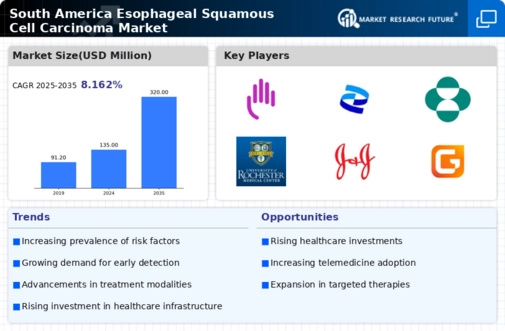Growing Patient Advocacy Groups
The emergence of patient advocacy groups in South America is fostering a supportive environment for individuals affected by esophageal squamous-cell-carcinoma. These organizations are instrumental in raising awareness, providing resources, and advocating for better treatment options. Their efforts are likely to lead to increased funding for research and improved access to care. In 2025, it is estimated that the influence of these groups will contribute to a 10% increase in patient enrollment in clinical trials, thereby driving innovation within the esophageal squamous-cell-carcinoma market.
Government Initiatives and Funding
Government initiatives aimed at combating cancer in South America play a pivotal role in shaping the esophageal squamous-cell-carcinoma market. Increased funding for cancer research and treatment programs is being observed, with several countries allocating substantial budgets to improve healthcare outcomes. For instance, Brazil has committed over $200 million to cancer research in 2025, which is likely to enhance treatment accessibility and innovation. These initiatives not only support the development of new therapies but also facilitate public health campaigns, ultimately driving market growth.
Rising Investment in Biopharmaceuticals
The surge in investment in biopharmaceuticals is significantly influencing the esophageal squamous-cell-carcinoma market in South America. Pharmaceutical companies are increasingly focusing on developing targeted therapies and immunotherapies for esophageal cancer. In 2025, it is anticipated that the biopharmaceutical sector will witness a growth of approximately 20% in South America, driven by the demand for innovative treatment options. This influx of investment is likely to accelerate the development of new drugs, enhancing treatment efficacy and expanding the market.
Technological Advancements in Diagnostics
Technological advancements in diagnostic tools are transforming the landscape of the esophageal squamous-cell-carcinoma market in South America. Innovations such as liquid biopsies and advanced imaging techniques are enabling earlier and more accurate detection of the disease. The adoption of these technologies is expected to increase, with market analysts projecting a growth rate of 15% in the diagnostic segment by 2027. Enhanced diagnostic capabilities are likely to lead to improved patient outcomes and increased treatment uptake, thereby positively impacting the overall market.
Increasing Awareness and Screening Programs
The rising awareness regarding esophageal squamous-cell-carcinoma in South America is a crucial driver for the market. Educational campaigns and screening programs are being implemented to enhance early detection rates. This increased awareness is likely to lead to a higher number of diagnoses, thereby expanding the patient pool. In 2025, it is estimated that the incidence of esophageal cancer in South America could reach approximately 10,000 new cases annually. As more individuals become aware of the symptoms and risk factors, the demand for diagnostic services and treatment options in the esophageal squamous-cell-carcinoma market is expected to grow significantly.


















Leave a Comment